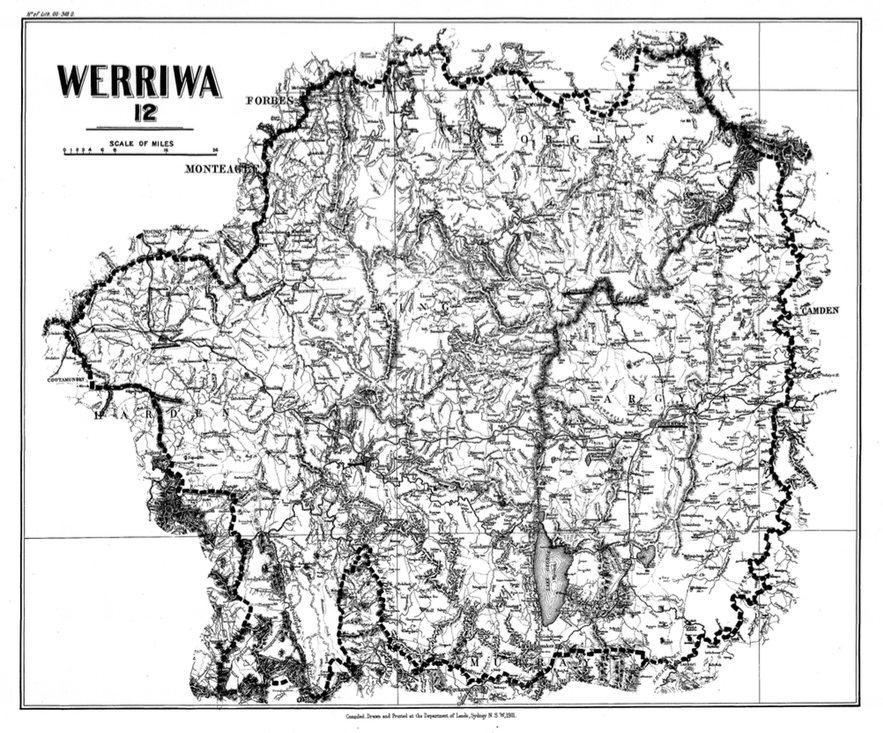
Gough Whitlam represented the federal electorate of Werriwa from a 1952 by-election until his resignation in 1978. The electorate has a long history of being held by Labor, ever since the 1930s. From 1934 until 2005, the seat was only held by four MPs, three of whom rose to a high rank in the federal ALP. Gough Whitlam from 1952 to 1978, and then John Kerin from 1978 to 1994 and Mark Latham from 1994 to 2005. Kerin served as Treasurer in the Hawke government, and Latham led the ALP to the 2004 election. From 1954 to 2005, every change of MP in Werriwa took place at a by-election.
The 2005 by-election was won by Chris Hayes, who held the seat until 2010. In 2010, he shifted to the seat of Fowler, immediately north of Werriwa, and Laurie Ferguson, who had represented Reid since 1990, took over Werriwa.
I have a particular personal interest in Werriwa. I lived in the electorate for most of my life until 2010, and ran in the electorate in 2004 and at the 2005 by-election.
Werriwa is a particularly fascinating seat, and that’s what I want to cover today.
Werriwa has existed continuously as a federal electorate since 1901, but the seat covers a very different area today to its original territory in 1901. Werriwa originally covered a large part of southern New South Wales, including Lake George (which gives the seat its name) and what is now the northern suburbs of Canberra.
With the use of historical maps, I’m going to trace how Werriwa shifted regions gradually over time, moving from a southern NSW rural electorate to a suburban seat in south-western Sydney.
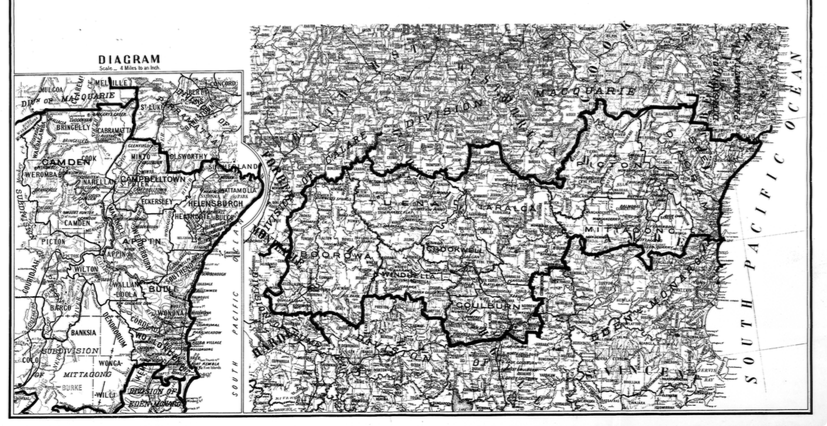
The first set of federal electoral boundaries were drawn in 1900, and Werriwa was a large, rural electorate. The seat included the major centres of Yass and Goulburn. It also stretched south to the Molonglo River, covering what is now the northern suburbs of Canberra. The seat did not include Cootamundra, but included areas immediately to the east of Cootamundra.
The name “Werriwa” is the local indigenous name for Lake George, a lake immediately to the north-east of Canberra.
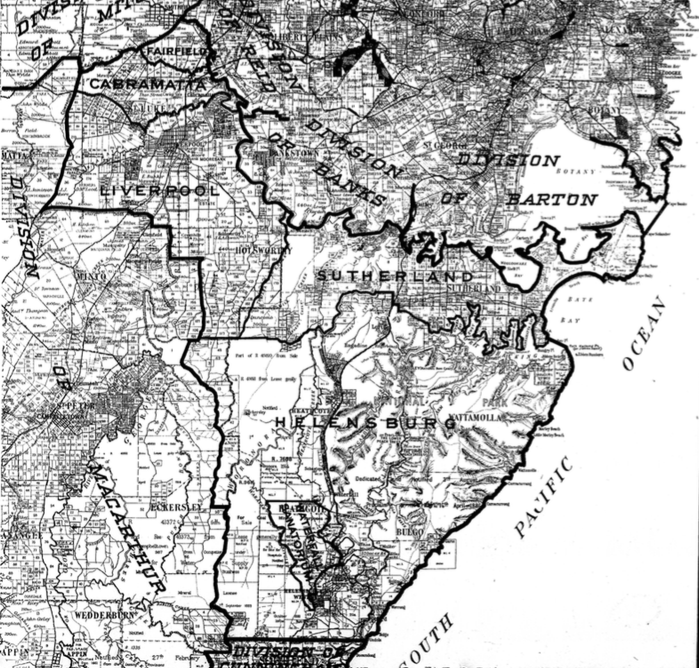
The original seat of Werriwa was won in 1901 by the Free Trade party.
At the next redistribution in 1906, Werriwa began its shift towards Sydney, losing those areas now contained in Canberra, and its southern border ran along the northern shore of Lake George. The seat also gained Cootamundra, and continued to cover Yass and Goulburn. The new boundaries in 1906 saw the seat won by Labor for the first time. Labor retained the seat in 1910.
The 1913 redistribution saw the seat shift further north, losing Yass and more areas near the current city of Canberra. The seat became a thin seat running east-west, from Grenfell in the west to Mittagong, Picton and Moss Vale in the east. At the 1913 election, the seat was won by the Liberal Party, but Labor won the seat back in 1914. Labor MP John Lynch left the party in 1916 over the conscription fight, and was re-elected once in 1917 as a Nationalist. He lost his seat in 1919 to Labor’s Bert Lazzarini.
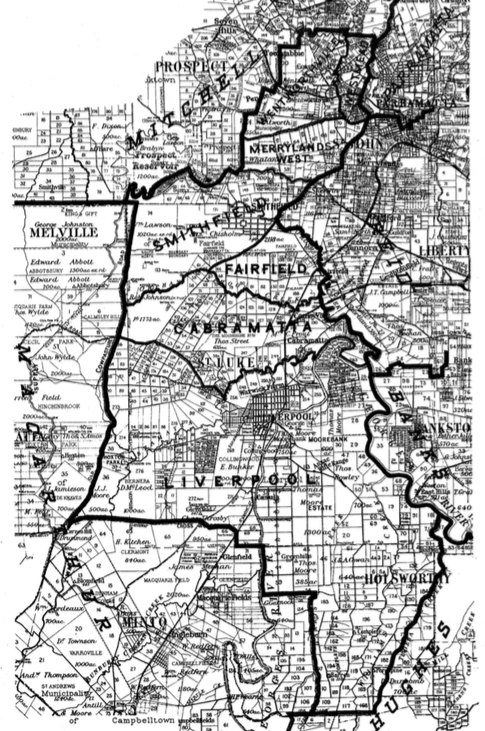
The 1922 boundaries shifted Werriwa further east, reaching the coast and the outskirts of Sydney. The seat stretched as far west as Boorowra, but on its eastern boundary it included Wollongong, Heathcote, Campbelltown, Camden and Cabramatta. The seat still contained Goulburn.
Lazzarini held on to the seat from 1919 to 1931, but in his final year he left the ALP to join the Lang Labor breakaway party. Lazzarini lost Werriwa in 1931 to the Country Party’s Walter McNicoll.
In 1934, another set of boundaries saw Goulburn distributed out of Werriwa for the first time since Federation.
The new boundaries saw the seat entirely contained in the Illawarra region, the Southern Highlands and the southwestern fringe of Sydney, including Cabramatta, Holsworthy and Sutherland.
The new boundaries were more friendly to Lazzarini, who won the seat back (as a Lang Labor candidate). He rejoined the ALP in 1936.
Werriwa shrunk even more in 1948, coming closer to Sydney. The 1948 redistribution saw a large increase in the number of electorates, so Werriwa was one of many seats covering a smaller area.
The new Werriwa covered Cabramatta, Fairfield, Liverpool, the entire Sutherland region as well as Helensburgh.
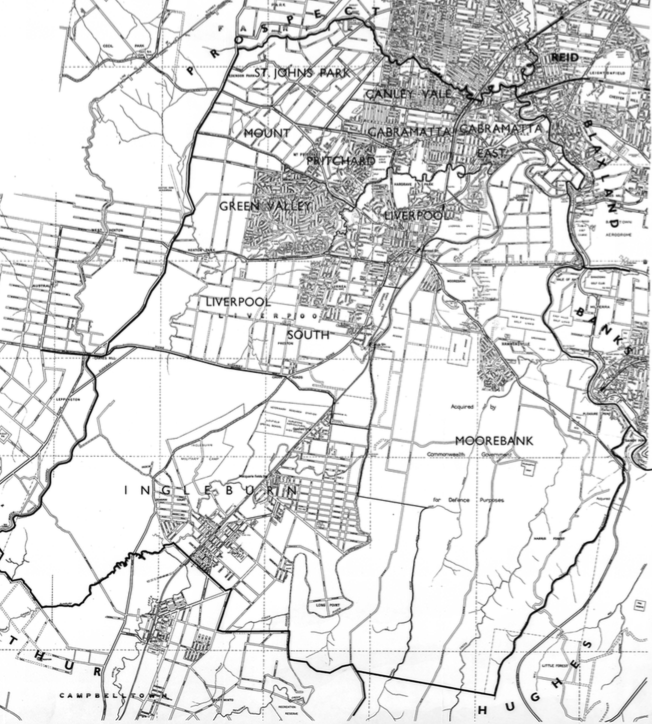
Lazzarini was re-elected on the new boundaries in 1949 and 1951, but died in 1952. The 1952 by-election, won by Gough Whitlam, was fought on the 1948 boundaries, and Whitlam was re-elected in 1954.
New boundaries were drawn for the 1955 election, and Werriwa lost the Sutherland area and moved deeper into Western Sydney. Werriwa in 1955 stretched from Holsworthy in the south to Wentworthville in the north. Gough Whitlam was re-elected to represent this area in 1955, 1958, 1961, 1963 and 1966.
Werriwa finally began to resemble the seat of today after the 1968 redistribution. This electorate stretched from Ingleburn in the south to Cabramatta and Canley Vale in the north.
These were the boundaries that Gough Whitlam represented as Labor leader, winning this version of Werriwa in 1969, 1972, 1974 and 1975.
The next redistribution, in 1977, cut out Cabramatta and shifted Werriwa south to take in the centre of Campbelltown. Werriwa has remained a seat based on the Campbelltown and Liverpool local government areas since the 1977 election. Gough Whitlam won Werriwa one last time in 1977, and resigned in 1978. The 1978 by-election was won by John Kerin.
Werriwa became a seat almost entirely contained in the City of Campbelltown in 1984, and shifted slightly north into Liverpool in 1992. The 2000 redistribution saw Werriwa lose the Campbelltown city centre and gain more parts of Liverpool LGA, and the seat has only undergone minor changes at the 2006 and 2009 redistributions.
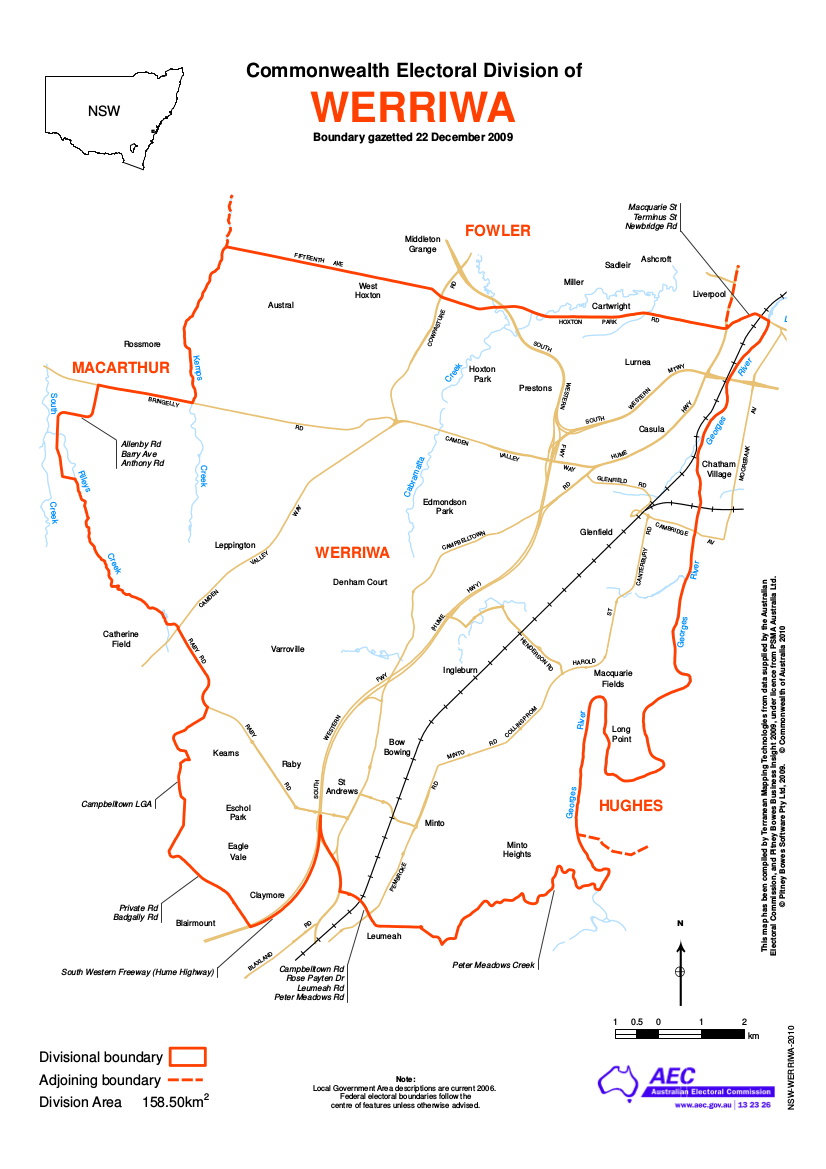



Ben
Correct however.The AEC ARE supposed to take into account future growth. WRT Wentworth they clearly failed – massively. To be fair automatic/direct enrolment has, & will have quite an effect.
However these boundaries will have to last 7 years,not 5 like the last one, & 3 of these 4 seats will grow enormously in population. 50,000+ additional voters is likely.
Therefore, the AEC will have to move a lot more than 15000 voters IMV. Would it be enough, or competent to simply draw these electorates down to quota ??. Not IMV.
Interms of re- drawing seats the AEC is supposed to try & concentrate as few LGA ‘s in seats as possible. Community of interest or such..
We will see . Thanks for your view though
cheers WD
Mark Mulcair
Agree about Canberra, Namadji etc.
I don’t think that airily suggesting that the north coast seats will topped up by the flow on from the south will do it. They are just too far under quota.
Sooner or later Page will need to take a northern part of New England, & push N.E. south.
Might as well be now.
Parkes, Calare, ^Hume arn’t under quota, & are growing well.
Farrer is just too big. If Susan Ley wasn’t a pilot it would cost us a fortune !!. I can’t accept that making Parkes huge is a solution either.
Your adjustments to Reid would only affect Watson, so does that mean Watson takes up Ashfield LGA, & or Leichardt LGA ??. Not so easy eh ??.
I just don’t think anyone gets how much population will go into the inner city in the next 8 years, which is what we are talking.
I’m sure I will find a way to make it work, winediamond 😉
Wine diamond I think ur overstating the population growth in inner sydney. Yes it is growing but not at a high rate ur suggesting. I’d say with a north west rail link that the north west will probably grow at a higher and faster rate then the inner city but I don’t think there is enough patterns to justify drastically altering the inner suburb seats to suit a liberal advantage and to create out of the ordinary seats. In fact redistribution talk is focusing on what the seat of parramatta will look like as well as the regions, inner sydney won’t be a priority much
Observer
I’m not going to repeat or argue WRT growth. The lib advantage comes from demographic change, & urban consolidation, NOT from an inevitable redistribution outcome. Your lack of objectivity shows.
What is the issue with Parramatta??
After it was declared labor there was discussions that it could move further north into winston hills and north rocks
Nah…the northern Sydney seats will need to expand a little, so Parramatta is likely to be pushed southwards. Likely to benefit Labor.
The AEC does take into account future growth. Projection figures are produced by the ABS.
The report of the last redistribution shows that Wentworth was 4.9% over quota on Feb 2009 figures and forecast to be 2.68% over quota on the projected July 2012 figures. (The requirement for the latter figure is +/- 3.5%)
So instead of shrinking, Wentworth’s surplus has grown. That’s just the way it goes sometimes. The people who crunch these numbers don’t have psychic powers.
And it’s rather absurd to assert that areas within the City of Sydney don’t share a community of interest with the electorate that covers the rest of the City of Sydney. Is Kings Cross really more eastern suburbs than it is city? Please.
It’s London to a brick that all or part of Woolloomooloo/Potts Point/Darlinghurst will be redistributed to the division of Sydney.
David Walsh
It goes back to the previous redistribution, & they got it wrong big time. simple. In the 09 boundaries they got a lot more wrong than right. They didn’t need psychic powers just the numbers, a brain or 2 would have helped….
Thanks for posting the numbers though
cheers WD
Hang on, no changes were made to Wentworth in 2009 – so your issue is that the AEC kept the existing boundaries, which fit within the quota, instead of an unnecessary radical redrawing?
David Walsh
Maybe not down & dirty Darlo. But Elizabeth Bay, Potts Point, Rushcutters Bay, need i go on ??. I wouldn’t be so sure about your London bricks!!!. This is a place where the libs will fight hard in submissions.
Remember the mobilisation Malcolm engineered in his dodgy pre-selection battle !!!.
Why will the Liberal Party care about losing these areas? The City of Sydney was the only part of Wentworth where Labor won in 2010 (I don’t have the 2013 figures to hand).
Ben
Correct. As i said previously Wentworth has been over quota for nearly 15years. WTF!!!
So they will make it smaller. I really don’t see why it’s a problem to make Wentworth a bit smaller.
The projection figures at the time showed Wentworth’s surplus was shrinking. Given what was known then, it made perfect sense to keep the shape of the seat stable.
You’re playing 20/20 hindsight at its most vulgar.
The redistribution is based on population now what the major parties want. Theres nothing wrong with some parts of the city of sydney being in Wentworth as its an inner city seat
should be not instead of now
I don’t understand the problem, winediamond?
Wentworth is over quota so will lose Kings Cross/Potts Point to Sydney, which will then lose Newtown and surrounds to Grayndler.
Libs benefit in Wentworth, Labor benefit vs Greens in Sydney, and Greens benefit in Grayndler. It’s every-child-wins-a-prize.
And what is the “big stuff up” you keep talking about in 2009? That redistribution fixed most of the major anomalies from the 2006 redistribution (which WAS a bit of a stuff up).
Just had a look back at the redistribution before last in 2005. That shows the 2004 boundary between Wentworth and Sydney followed the City of Sydney boundary.
So those areas weren’t even part of Wentworth when Turnbull ousted Peter King. (If it even mattered.)
Are u saying tht LGA’s should be deciding boundaries?
LGA boundaries can be good when they follow major roads or features. From memory the Sydney/Wollhara(?) boundary ran along a major road, and was a good boundary between “inner city” and “eastern suburbs”. Made perfect sense as Wentworth’s western boundary; unfortunately they had to move it to help Wentworth gain electors.
I’m not saying LGA boundaries necessarily make for the best federal division boundaries. (Ideally they would, but many urban LGA boundaries are badly in need of revision.)
My last point was simply that there is a recent precedent for these areas being within the division of Sydney.
And even if there weren’t, their presence within the City of Sydney contradicts any notion of there not being a shared community of interest.
Ben
It is the knock on effect to K-S.
David Walsh
My MUM still lives in Wentworth, (i left 35 years ago). She is always incensed whenever i propound the virtues of ALL development & urban consolidation!!!. As a taxpayer i believe the whole of the east ought to become high rise, tuscan villas, & huge marinas etc.
Any idiot could have seen in 2004 what was going to happen development, & therefore population wise in the future. The state govt had a policy FFS.
Some of her friends have even decided they do’t like me very much….
i wasn’t aware LGA boundaries could be changed, or easily at that.
Observer
LGA’s are important. Isn’t it better to have one MP representing an LGA than 2 or even 3 in my case (willoughby) for many years.
Of course LGA boundaries can be changed. Kennett did it. Beattie did it. Barnett is in the process of doing it. Successive NSW govts have continuously tinkered with the City of Sydney. The current one has a review underway. Indeed, Baird has recently backed away from O’Farrell’s earlier promise of “no forced amalgamations”. But local govt rationalisation is another discussion in itself…
I find your “any idiot could have seen” line of argument rather obnoxious. We’re talking about forecasting here; an imperfect science. And really, what’s your point? If the commission did got it wrong previously, all the more reason to correct that next time.
Winediamond, what knock-on effects on Kingsford-Smith? Kingsford-Smith is on quota, requires no change, and sits in a corner where no other seats will create knock-ons. There is an obvious place to cut the Wentworth population that doesn’t affect Kingsford-Smith.
Also, even if a seat is growing in the future they must make the boundaries fit to the quota criteria, and they did that in Wentworth.
I just had a quick look at the enrolment figures….5 years after the redistribution, every seat in NSW is still only 10% +/- from quota. That’s actually really good considering the disparity in growth across the state.
It’s not like Wentworth is 50% over quota or something. It’s 9% over, and can easily be fixed with a logical deletion to Sydney. No dramas whatsoever.
Ben
As i’ve said previously there are about 7000 voters from Randwick LGA IN Wentworth. IMO they ought to be in K-S , that is all.
Apart from that small chunk of Randwick LGA in Kingsford Smith, the electorate covers all of Randwick and Botany council areas – very neat, but those two councils are just slightly too big to have a single electorate cover them. So to align that council boundary you would completely mess up the boundaries at the other end? Also if you were to move the entirety of Botany Bay Council into Grayndler as you suggest, Kingsford-Smith would need to gain a lot more than 7000 voters from Wentworth, shifting it far into Waverley. There’s no neat solution, but leaving Kingsford-Smith alone seems the most sensible.
Mark Mulcair
I’m not trying to be obnoxious. IMV the trend was obvious. Any experience or knowledge of the area concerned confirms it.
Mark Mulcair
Sorry my previous post was actually to David Walsh. You are absolutely correct, if there is no allowance for the growth that will come.
Ben
Yes you are correct on a short term basis. MY contention has always been that this kind of change is inevitable. IMO the current boundary is not so neat, & will be a lot less so over the next 8 years. There will be a lot of development over this time.
I don’t understand the problem with “projected growth”? The AEC will estimate projected growth based on current trends….if they under-estimated it last time, they will get closer to the expected trend this time.
The fact that every seat is within 10% of quota five years later suggests their growth projection last time was actually pretty good. Yes, they under-estimated in Wentworth slightly, but we’re still only talking 9-10% here. A simple deletion to Sydney, of suburbs that would fit perfectly well in Sydney, is all that is needed. If K-S is projected to grow, it can just dribble a few more Randwick voters in Wentworth. Simple and logical.
Mark Mulcair
As i’ve said previously. That is fine as long as the approach is minimalist , & short term. IMO it is simply inadequate.
No one predicted the rate of population growth in the inner city over the past few years. A decade ago everyone thought places like the north coast would have the fastest population growth in the state. In fact if you believed some demographers the north coast is meant to have been some kind of swarming metropolis by now – there were some quite ridiculous projections that failed to give any consideration to the practicalities of how such growth could actually be accommodated in reality. Agencies such as the ABS were a little more realistic, but they got it wrong too. Population in western NSW has continued to decline faster than anticipated, and there’s been a surge of population in the inner city. I’m sure in previous decades there’s been similar mistakes in predicting growth trends.
Insofar as ‘short-term’ and ‘long-term’ changes, the AEC can really only deal with the ‘short-term’ of the time period over which the projections apply, because the number of seats allocated to each state changes, not to mention that the size of the House of Reps can also theoretically be varied. It wouldn’t make much sense for the AEC to try to design electorates thinking 2 or 3 redistributions ahead when it can’t forsee how the future quotas may change.
Increase in high rise won’t necessarily mean a high enough population alter boundaries, if anything population will increase faster in the suburbs. It would be idiotic for the AEC to make boundary changes based on predictions of where the population might increase. If it doesn’t increase at the predicted rate then you would have made a seriously bad call for 6 years in an electorate
There’s no strict requirement for former Prime Ministers to have seats named after them in areas that they represented. Certainly Barton, Deakin, Bruce, Forde, and Chifley are urban seats named after Prime Ministers from provincial seats.
I personally think that the Central Coast seat of Dobell should be renamed Whitlam. I don’t see the importance of the individual after whom Dobell is named, the seat is continually urbanising in a way similar to Werriwa during Whitlam’s time as member, and the Central Coast in general swung to Whitlam in 1969 and has largely stayed with Labor ever since – only from 1996 to 2007 and then from 2013 have the Liberals represented this area.
Hhhm, there is a degree of local connection for Dobell. William Dobell was a Newcastle native who later based himself on the Central Coast; albeit at Wangi Wangi on Lake Macquarie which is in the neighbouring seat of Charlton. Arguably you could re-name Charlton (which is only named after an Opposition Leader) as Dobell and anoint the current Dobell as Whitlam. However, Charlton did have life-long links to the area covered by Charlton so there is a viable counter-argument.
If they were to go looking elsewhere in NSW for a seat to rename, surely they would choose one of the many still afflicted with geographical names rather than Dobell or Charlton. It would be good to rename Sydney at some point too, since it’s not a federation division and there’s also a state district of that name, something they’re suppose to try to avoid.
Richmond desperately needs renaming since it no longer contains the Richmond River, and hence is now a confusing name. I doubt we could make a case for it to get renamed Whitlam though.
Richmond could be renamed “Anthony”. That would be a good fit for the seat with the history it had.
Sydney will surely stay, every mainland capital city has a namesake seat. I’d sooner drop Warringah or Berowra, or even Parramatta (despite being a federation seat).
I suspect Chifley and Bruce represented areas covered by their now namesake seats; not sure though. Nonetheless, Warren’s point is well taken.
Moore in WA is pretty confusing too, largely because there’s both a state and federal seat with that name which completely don’t overlap. The federal seat is outer suburban Perth, the state seat is the northern wheatbelt. Once upon a time they both contained the Moore River (and the federal seat is still named after the same guy the river is), but the last few decades worth of redstributions have completely changed that. If Canning gets redrawn out of Perth to make way for seat #16, the same thing could happen there too.
WA also used to have a state seat named Stirling down near Albany, which wasn’t even slightly connected to the federal one in Perth. Both were named after geographical locations which were in turn named after James Stirling. That’ll happen when the same half a dozen names of early white settlers keep on getting used again and again.
Comments are closed.